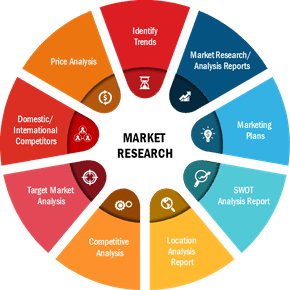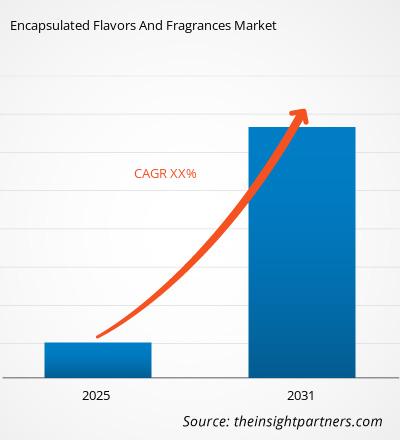La encapsulación o encapsulación de microsabor consiste en proteger un agente aromatizante o moléculas de fragancia con una envoltura específica. La encapsulación puede minimizar la degradación o pérdida del sabor o la fragancia durante los diversos procesos y almacenamiento de los productos. La envoltura también puede proporcionar propiedades funcionales como la liberación controlada de moléculas aromáticas en un entorno determinado.
DINÁMICA DEL MERCADO
El mercado de sabores y fragancias encapsulados ha sido testigo de un crecimiento significativo debido a factores como la creciente preferencia de los consumidores hacia productos alimenticios convenientes, como snacks nutritivos y aromatizados listos para comer. Hoy en día, los clientes disfrutan de la idea de sabores en diferentes tipos de alimentos, como galletas, helados, etc., lo que se está convirtiendo en un fenómeno hoy en día en la industria de alimentos y bebidas. La alta demanda por parte de los clientes del sabor original y la fragancia de los productos es uno de los impulsores clave del mercado de sabores y fragancias encapsulados. Los países desarrollados como EE.UU., el Reino Unido, Alemania, Japón, etc. están desarrollando su tecnología junto con las instalaciones de I+D basadas en alimentos, así como la industria de encapsulación de sabores que los productores pueden adoptar fácilmente, y este desarrollo tecnológico también está impulsando la demanda. Sin embargo, los consumidores actuales preocupados por su salud siempre tienen curiosidad por saber todo lo que contienen sus alimentos y si las normas alimentarias lo autorizan todo. El cumplimiento para mantener la calidad del producto final y los estándares regulatorios es una de las principales limitaciones para el crecimiento de los actores del mercado. El crecimiento significativo de las industrias de procesamiento de alimentos tanto en los países desarrollados como en los países en desarrollo también está contribuyendo al crecimiento del mercado de sabores y fragancias encapsulados.
ÁMBITO DEL MERCADO
El "Análisis del mercado global de sabores y fragancias encapsulados hasta 2031" es un estudio especializado y en profundidad de la industria de alimentos y bebidas con un enfoque especial en el análisis de tendencias del mercado global. El informe tiene como objetivo proporcionar una descripción general del mercado global de sabores y fragancias encapsulados con una segmentación detallada del mercado por tipo, canal de distribución y geografía. Se espera que el mercado mundial de sabores y fragancias encapsulados experimente un alto crecimiento durante el período de pronóstico. El informe proporciona estadísticas clave sobre el estado del mercado de los principales sabores y fragancias encapsulados a nivel mundial y ofrece tendencias y oportunidades clave en el mercado.
SEGMENTACIÓN DEL MERCADO
Los sabores y fragancias encapsulados globales están segmentados según el tipo de producto, la tecnología y la aplicación. Según el tipo de producto, el mercado mundial de sabores y fragancias encapsulados se puede segmentar en mezclas de sabores, mezclas de fragancias, aceites esenciales y extractos naturales y productos químicos aromáticos. Sobre la base de la tecnología, los sabores y fragancias encapsulados globales se segmentan en proceso físico, proceso fisicoquímico, proceso químico, extrusión, lecho fluido y otros. Según la aplicación, el mercado mundial de sabores y fragancias encapsulados se puede segmentar en alimentos y bebidas, artículos de tocador, productos de limpieza y otros.

El informe proporciona una descripción detallada de la industria que incluye información tanto cualitativa como cuantitativa. Proporciona una descripción general y un pronóstico del mercado mundial de sabores y fragancias encapsulados en función de varios segmentos. También proporciona el tamaño del mercado y estimaciones de pronóstico para el año 2021 al 2031 con respecto a cinco regiones principales, a saber; América del Norte, Europa, Asia-Pacífico (APAC), Medio Oriente y África (MEA) y América del Sur. El mercado global de sabores y fragancias encapsulados de cada región se subsegmenta posteriormente en los respectivos países y segmentos. El informe cubre el análisis y pronóstico de 18 países a nivel mundial junto con la tendencia actual y las oportunidades que prevalecen en la región.
El informe analiza los factores que afectan el mercado global de sabores y fragancias encapsulados tanto desde el lado de la demanda como de la oferta y evalúa más a fondo la dinámica del mercado que afecta al mercado durante el período de pronóstico, es decir, impulsores, restricciones, oportunidades y futuro. tendencia. El informe también proporciona un análisis PEST exhaustivo para las cinco regiones, a saber; Norteamérica, Europa, APAC, MEA y Sudamérica después de evaluar los factores políticos, económicos, sociales y tecnológicos que afectan los sabores y fragancias encapsulados globales en estas regiones.

JUGADORES DEL MERCADO
Los informes cubren desarrollos clave en el mercado global de sabores y fragancias encapsulados como estrategias de crecimiento orgánico e inorgánico. Varias empresas se están centrando en estrategias de crecimiento orgánico como lanzamientos de productos, aprobaciones de productos y otros como patentes y eventos. Las actividades de estrategias de crecimiento inorgánico observadas en el mercado fueron adquisiciones y asociaciones y asociaciones. colaboraciones. Estas actividades han allanado el camino para la expansión de los negocios y la base de clientes de los actores del mercado. Se anticipa que los participantes del mercado de sabores y fragancias encapsulados globales tendrán lucrativas oportunidades de crecimiento en el futuro con la creciente demanda de sabores y fragancias encapsulados en el mercado global. A continuación se menciona la lista de algunas empresas dedicadas a los sabores y fragancias encapsulados a nivel mundial.
El informe también incluye los perfiles de empresas clave junto con su FODA Análisis y estrategias de mercado en el mercado global de sabores y fragancias encapsulados. Además, el informe se centra en los principales actores de la industria con información como perfiles de empresas, componentes y servicios ofrecidos, información financiera de los últimos 3 años, el desarrollo clave en los últimos cinco años.
- •AVEKA•BÜCHI Labortechnik AG•Cargill•Firmenich SA•FONA International Inc.,•Glatt GmbH•Ingredion Incorporated•Lycored•Sensient•Tate & Lyle plc
El equipo dedicado de investigación y análisis de Insight Partner está formado por profesionales experimentados con conocimientos estadísticos avanzados y ofrece varias opciones de personalización en el estudio existente.

- Análisis histórico (2 años), año base, pronóstico (7 años) con CAGR
- Análisis PEST y FODA
- Tamaño del mercado Valor/volumen: global, regional, nacional
- Industria y panorama competitivo
- Conjunto de datos de Excel


- Rugged Phones Market
- Automotive Fabric Market
- High Speed Cable Market
- Artificial Intelligence in Healthcare Diagnosis Market
- Europe Industrial Chillers Market
- Energy Recovery Ventilator Market
- Employment Screening Services Market
- Nurse Call Systems Market
- Redistribution Layer Material Market
- Lyophilization Services for Biopharmaceuticals Market

Report Coverage
Revenue forecast, Company Analysis, Industry landscape, Growth factors, and Trends

Segment Covered
This text is related
to segments covered.

Regional Scope
North America, Europe, Asia Pacific, Middle East & Africa, South & Central America

Country Scope
This text is related
to country scope.
Trends and growth analysis reports related to Food and Beverages : READ MORE..
The List of Companies
1. AVEKA
2. BÜCHI Labortechnik AG
3. Cargill
4. Firmenich SA
5. FONA International Inc.,
6. Glatt GmbH
7. Ingredion Incorporated
8. Lycored
9. Sensient
10. Tate and Lyle plc
The Insight Partners performs research in 4 major stages: Data Collection & Secondary Research, Primary Research, Data Analysis and Data Triangulation & Final Review.
- Data Collection and Secondary Research:
As a market research and consulting firm operating from a decade, we have published and advised several client across the globe. First step for any study will start with an assessment of currently available data and insights from existing reports. Further, historical and current market information is collected from Investor Presentations, Annual Reports, SEC Filings, etc., and other information related to company’s performance and market positioning are gathered from Paid Databases (Factiva, Hoovers, and Reuters) and various other publications available in public domain.
Several associations trade associates, technical forums, institutes, societies and organization are accessed to gain technical as well as market related insights through their publications such as research papers, blogs and press releases related to the studies are referred to get cues about the market. Further, white papers, journals, magazines, and other news articles published in last 3 years are scrutinized and analyzed to understand the current market trends.
- Primary Research:
The primarily interview analysis comprise of data obtained from industry participants interview and answers to survey questions gathered by in-house primary team.
For primary research, interviews are conducted with industry experts/CEOs/Marketing Managers/VPs/Subject Matter Experts from both demand and supply side to get a 360-degree view of the market. The primary team conducts several interviews based on the complexity of the markets to understand the various market trends and dynamics which makes research more credible and precise.
A typical research interview fulfils the following functions:
- Provides first-hand information on the market size, market trends, growth trends, competitive landscape, and outlook
- Validates and strengthens in-house secondary research findings
- Develops the analysis team’s expertise and market understanding
Primary research involves email interactions and telephone interviews for each market, category, segment, and sub-segment across geographies. The participants who typically take part in such a process include, but are not limited to:
- Industry participants: VPs, business development managers, market intelligence managers and national sales managers
- Outside experts: Valuation experts, research analysts and key opinion leaders specializing in the electronics and semiconductor industry.
Below is the breakup of our primary respondents by company, designation, and region:

Once we receive the confirmation from primary research sources or primary respondents, we finalize the base year market estimation and forecast the data as per the macroeconomic and microeconomic factors assessed during data collection.
- Data Analysis:
Once data is validated through both secondary as well as primary respondents, we finalize the market estimations by hypothesis formulation and factor analysis at regional and country level.
- Macro-Economic Factor Analysis:
We analyse macroeconomic indicators such the gross domestic product (GDP), increase in the demand for goods and services across industries, technological advancement, regional economic growth, governmental policies, the influence of COVID-19, PEST analysis, and other aspects. This analysis aids in setting benchmarks for various nations/regions and approximating market splits. Additionally, the general trend of the aforementioned components aid in determining the market's development possibilities.
- Country Level Data:
Various factors that are especially aligned to the country are taken into account to determine the market size for a certain area and country, including the presence of vendors, such as headquarters and offices, the country's GDP, demand patterns, and industry growth. To comprehend the market dynamics for the nation, a number of growth variables, inhibitors, application areas, and current market trends are researched. The aforementioned elements aid in determining the country's overall market's growth potential.
- Company Profile:
The “Table of Contents” is formulated by listing and analyzing more than 25 - 30 companies operating in the market ecosystem across geographies. However, we profile only 10 companies as a standard practice in our syndicate reports. These 10 companies comprise leading, emerging, and regional players. Nonetheless, our analysis is not restricted to the 10 listed companies, we also analyze other companies present in the market to develop a holistic view and understand the prevailing trends. The “Company Profiles” section in the report covers key facts, business description, products & services, financial information, SWOT analysis, and key developments. The financial information presented is extracted from the annual reports and official documents of the publicly listed companies. Upon collecting the information for the sections of respective companies, we verify them via various primary sources and then compile the data in respective company profiles. The company level information helps us in deriving the base number as well as in forecasting the market size.
- Developing Base Number:
Aggregation of sales statistics (2020-2022) and macro-economic factor, and other secondary and primary research insights are utilized to arrive at base number and related market shares for 2022. The data gaps are identified in this step and relevant market data is analyzed, collected from paid primary interviews or databases. On finalizing the base year market size, forecasts are developed on the basis of macro-economic, industry and market growth factors and company level analysis.
- Data Triangulation and Final Review:
The market findings and base year market size calculations are validated from supply as well as demand side. Demand side validations are based on macro-economic factor analysis and benchmarks for respective regions and countries. In case of supply side validations, revenues of major companies are estimated (in case not available) based on industry benchmark, approximate number of employees, product portfolio, and primary interviews revenues are gathered. Further revenue from target product/service segment is assessed to avoid overshooting of market statistics. In case of heavy deviations between supply and demand side values, all thes steps are repeated to achieve synchronization.
We follow an iterative model, wherein we share our research findings with Subject Matter Experts (SME’s) and Key Opinion Leaders (KOLs) until consensus view of the market is not formulated – this model negates any drastic deviation in the opinions of experts. Only validated and universally acceptable research findings are quoted in our reports.
We have important check points that we use to validate our research findings – which we call – data triangulation, where we validate the information, we generate from secondary sources with primary interviews and then we re-validate with our internal data bases and Subject matter experts. This comprehensive model enables us to deliver high quality, reliable data in shortest possible time.

 Obtenga una muestra gratuita de este informe
Obtenga una muestra gratuita de este informe